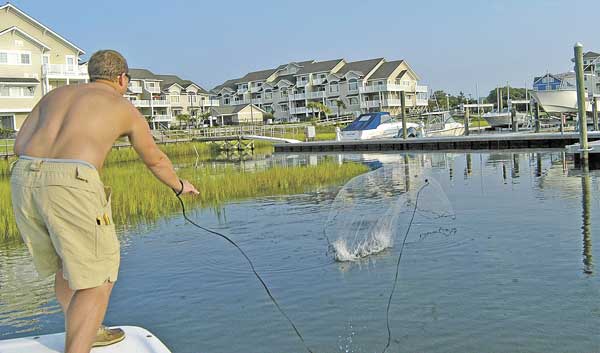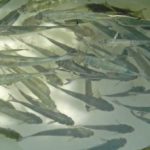
Old wars and sunken ships create No Vacancies at coastal flounder motels.
During the War Between the States, actively fought off the North Carolina coast from 1861 through 1865, the Union attempted to prevent goods from reaching Southern ports by creating shipping blockades with its navy. The Confederacy battled this attempt to strangle its economic lifeline with its own warships and private vessels, often taking on supplies offshore from English and French frigates and schooners, then trying to slip the goods past Yankee blockaders.
It was a cat-and-mouse game, usually won by Southern sailors because so many places existed to find safe harbor, tucked into the many inlets and river outlets along the coast. Still, the inevitable results, as in all shooting wars, were casualties on both sides and an ocean floor littered with burned-out hulks and bodies.
Moreover, unpredictable weather, particularly during late summer and early fall, meant violent storms took a punishing toll on ships and sailors from North and South.
Ultimately, the Union’s superior land and naval forces, along with its unmatched industrial might, prevailed. Eighty-four years later, World War II added more detritus to the bottom as German U-boats prowled and sank millions of tons of shipping until the U.S. Coast Guard and U.S. Navy beat the Nazi submariners back to Hitler’s Fortress Europe.
Although the South lost its war and American forces helped defeat Germany, the old Confederate coastline received an unexpected benefit from war’s carnage — a positive result the North doesn’t have to this day — myriad sunken structures that have served as homes for baitfish and gamefish for more than 100 years.
These piscatorial condominiums have been added to by man-made structures such as moth-balled Liberty Ships, barges and old menhaden boats, along with concrete pipes, parts of demolished bridges and other structures — often donated by fishing clubs.
Although Jimmy Price, the famed Southport guide, once dubbed the relatively-new reef balls “flounder motels,” shipwrecks in nearshore waters had served that purpose for generations.
“We’re going to fish a couple of old Confederate wrecks today,” said Dennis Barbour, 57, former mayor of Carolina Beach, owner of Island Hardware and Tackle and a part-time fishing guide who runs about three-dozen trips per year.
Fishermen targeting flounder during the summer can fish inshore waters for these tasty denizens, but tackling the Intracoastal Waterway, creeks, docks or marsh edges means trying for fish that get pounded daily.
Fishermen and commercial netters covet flounder because they make for great table fare. Wholesalers (and retail sites, such as restaurants) pay top dollar for flatties because the customers love ’em fried, poached or broiled. Today, that means these inshore fish — North Carolina waters hold two species, the “summer” and “southern” flounder — are in trouble. Summer flounder are listed as a species of “concern,” while southerns are “depleted.” Both are classified by the N.C. Marine Fisheries Commission’s stock-status report as “overfished.”
Meanwhile, the state allows commercial fishermen to set gill nets (some use pound nets or ocean trawls) for flounder. Inshore netters don’t waste their time setting nylon in shallow- water areas that don’t hold fish. And if you think they don’t know where the flounder live, think again. All these factors have conspired to drop a big, 1,000-pound sledgehammer on skinny-water flounder in North Carolina.
What does that mean to serious inshore fishermen dreaming of catching a big Paralichthys lethostigma or Paralichthys dentatus or simply catching enough flatties to take home for dinner? Mostly, it means to catch a mess of fish or a doormat, the best places will be off the beaches.
But it’s wrong to believe you have to go too far offshore to catch one. Sometimes, off-the-beach flounder live so close to the surf that fishermen in boats can see the brand of tanning lotion tourists use. A flounder excursion could mean a short jaunt off the beach to a bumpy ride three miles or so from the breakers to find a wreck in 40 to 60 feet of water.
“This first place we’ll try is pretty close to the beach,” said Barbour, as his son, Wes, 22, a business management major at Appalachian State, climbed to the bow of his dad’s Carolina Skiff with a cast net draped over his shoulder. Near the Carolina Beach Yacht Basin, the Barbours looked for tell-tale “Vs” on the surface created by schools of finger mullet.
“There’s some,” Dennis Barbour said, pointing toward a clump of half-submerged spartina grass off a point of marsh. A novice observer would have seen nothing except small gray wind ripples on the water, but Wes replied, “I got ’em.”
A few seconds later, he launched a spiraling umbrella of lead and nylon mesh that splashed in a perfect circle around the baitfish. About a dozen silvery 3- to 6-inch finger mullet found out what a topside trip was like before they were unceremoniously dumped into a bucket and dropped into the open maw of the livewell built into the stern of Barbour’s skiff. A few more tosses resulted in about 100 baits.
Barbour’s skiff wound up approximately 300 yards east of the northern tip of Carolina Beach, where day-trippers and fishermen had driven trucks onto the sand. Bikini-clad girls, children, husbands, boyfriends and a few fishermen with sand-spikes and surf rods dotted the sloping white strand between the high-tide line and hissing surf.
“(The daytrippers) are in the right area, but nobody’s gonna get a bait out to where the flounder are here,” Dennis Barbour said as he grabbed the anchor and his son pointed the skiff’s prow toward the inlet.
“I’m dropping anchor now; let the tide take us back, then I’ll tie us off,” he said.
Dennis Barbour pointed to a dark spot in the water about six feet below the surface and identified it as the remains of a Confederate shipwreck.
“It’s been here so long and through so many storms, it’s in pieces on the bottom,” Barbour said. “Sometimes it gets covered up by sand; today it’s not.”
Using a small dip net, he captured a wriggling finger mullet and hooked it first under the lower jaw, then pushed the hook point between the bait’s nostrils. He had 30-pound test braid spooled onto his Abu Garcia reels, which were mated to 6½-foot Key Largo rods. The terminus of his outfits feature a 1-ounce barrel weight, 10-inch leaders of 30-pound line, and Owner Cutting Point 3/0 or 4/0 wide-gap hooks.
“These (Key Largos) are tough rods,” he said. “We like their action; they’ve got some backbone to help you get a big flounder to the surface.”
A first encounter with a sunken wreck takes a little probing, because flounder don’t take up residence all around or inside such structure.
“They’ll usually be on one side or another, which means we’re gonna get hung up a few times,” Dennis Barbour said. “If you ain’t gettin’ hung up, you ain’t fishing in the right spot for these fish anyway.”
The Barbours found two small flounder, shorter than the 14-inch minimum size, at the south side of the sunken boat, which was about the size of an average living room.
“Let’s go try another spot down the beach,” Wes Barbour said.
About two miles south, a second sunken Confederate hulk, this one even closer to the beach, was the next stop. Vacationers standing on the balconies of a high-rise hotel watched two of Barbour’s buddies already bobbing almost on top of the wreck.
“That’s Charlie,” Barbour said. “He caught a 12-9 (12-pounds, 9-ounces) flounder from Snow’s Cut last week.”
With the other boat fishing that spot, Barbour turned his skiff seaward and motored to the “Liberty Ship” about three miles off the beach. It’s officially AR 370 but also known as the Meares Harris wreck.
The Barbours immediately began hooking up with flounder and soon were joined by “Charlie,” who’d given up at the inshore spot they’d just abandoned. The Barbours dropped baits to the bottom (52 feet deep), then slowly moved their rod tips or just allowed them to swim around the barrel weights.
“(Catching deep flounder) is just a matter of ‘feel,’” said Dennis Barbour. “That’s why I like braided line; it lets you feel bites better. You also can feel baits moving down there when something gets after them.”
Fishing deep in nearshore waters for flounder doesn’t require long waits once a fish takes the bait. At inside docks and around piers, veteran anglers often pause as long as a minute for a flounder to “scale” a baitfish before swallowing it. But in deep water, apparently the competition for food is too intense, so it’s a good idea to give a quick snap upward of the rod tip about five seconds after feeling a bite.
“Flounder fishing starts in May when the mullet and menhaden arrive, then gets really good near the end of July,” said Dennis Barbour. “It gets increasingly better and is best during October, but all summer long, you can catch flounder at these wrecks.”










Be the first to comment